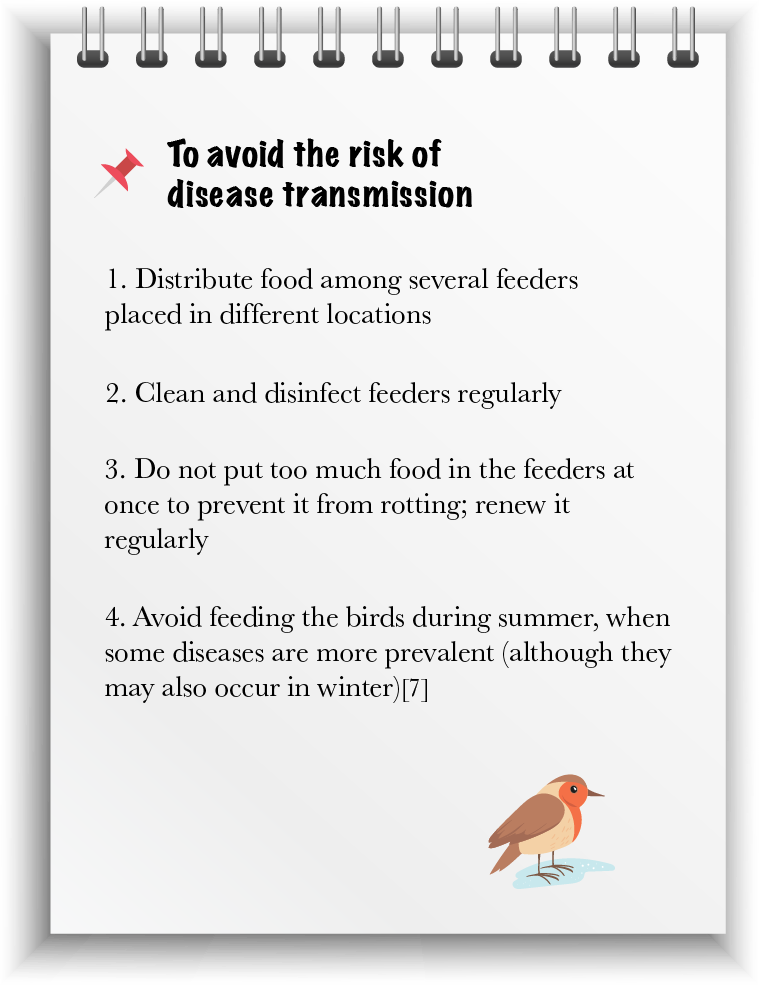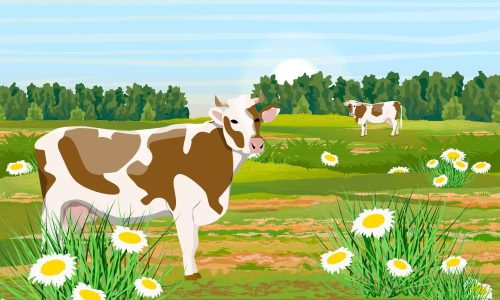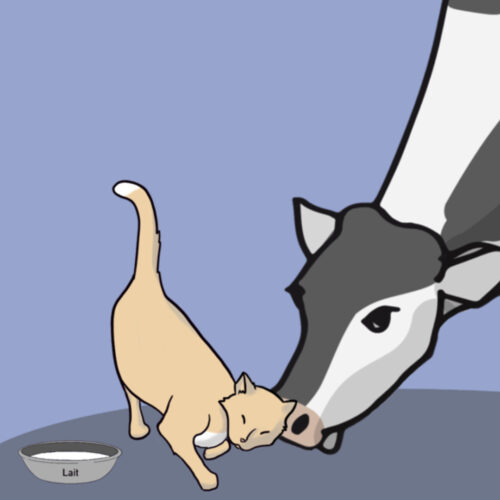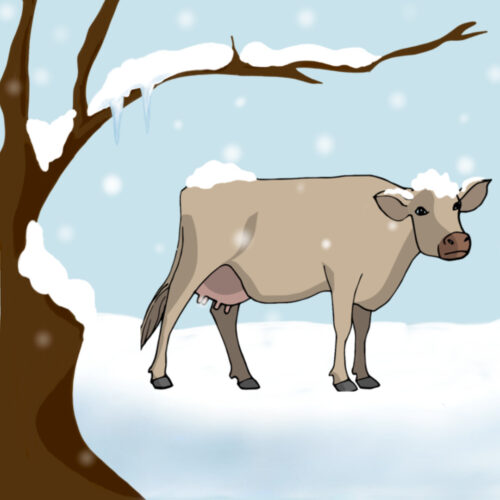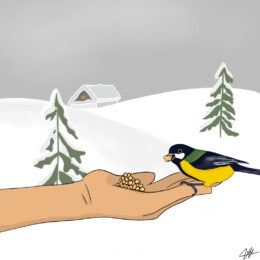

TRUE...
but only in periods of prolonged frost and using some precautions!
keep in mind
- Following a decline in birds population, feeding them in winter, but only in periods of prolonged frost, may be of interest to increase their chances of survival and ensure a more successful breeding season
- However, sanitary precautions must be taken, food must be carefully selected (no bread, no salt or net balls) and care must be taken to avoid creating dependency
- To help the birds all year round, it is better to favor an ecological management of our countryside and gardens!
During the winter season, birds are faced with decreasing resources and must adapt their foraging strategies. Feeding can become particularly difficult for them during prolonged periods of freezing temperatures. Ok then, but should we help them through the winter with extra food?

Did you know?
The birds that we feed in our gardens mainly eat insects, fruits, berries and seeds. In winter, with the cold, the number of insects decreases. Birds adapt their diet by feeding mainly on seeds and fruits (especially berries). They then become mainly granivorous.
Feeding birds to tackle biodiversity loss!
In 2021, the news came as a shock: between 1989 and 2019, the population of birds in the countryside and in the cities has declined by 30%[1]. Among the culprits: the reduction of food resources related to environmental degradation.

The main reason for the decline of birds is the decrease in available resources, such as food or favorable habitats for sheltering, breeding, or feeding during the breeding season or during wintering
NATIONAL MUSEUM OF NATURAL HISTORY
With this in mind, and in order to counteract this decrease in bird populations, it may be interesting to provide them with additional food to help them get through the winter and put them in a good position for the breeding season!

Did you know?
Some species of birds are used to looking for food on the ground: blackbirds, nightjars, flycatchers, robins. This is why bird feeders placed at a low height, close to the ground will be useful for them!

This way, birds fed during the winter may have a better chance of surviving the season[2] and may be in better overall health (less stress, higher antioxidant levels, better immune system, nicer plumage)[3]. Some scientists believe – although not all studies concur – that birds may also have a more successful breeding season (more chicks with a better survival rate)[4].
📌 Ideas
- Birds should be fed at regular intervals, or make sure to fill feeders regularly since predictability tends to reduce their stress, allowing them to better store fats[5].
- Also remember to provide them with water, which can be difficult to find during prolonged freezing temperatures!
But there are several risks to take into account...
However, caution is advised when deciding whether to feed birds as this can have significant adverse effects, either by directly impacting the birds themselves or by affecting more complex ecological dynamics.
The risks of feeding for the birds themselves
One of the main risks concerns is health! Indeed, birds that gather in the same place are likely to transmit diseases to each other, sometimes resulting in death[6].
The question of animal dependence on food is also relevant. Scientists do not all agree on this matter[8]. In any case, it is very likely:
- that to stop feeding the birds suddenly, especially during the cold season, can have dramatic consequences for their survival
- that feeding, in general, can lead animals to make sub-optimal choices by promoting what are called “ecological traps”. Birds, because of the abundance of food associated with feeding, are encouraged to remain in one place, increasing their concentration even though naturally available resources are actually not sufficient to feed them all
- that some birds may in some cases become entirely dependent on human food supplies to get through the winter[9]. Such dependence observed locally and on an ad hoc basis by scientists, is not desirable. Food distributed by man should be a form of supplementation. It should not in any way replace available natural resources. This is why feeding must be reasoned and limited to prolonged periods of freezing
Furthermore, gathering animals around the same feeding points may increase predation. However, this potential increase is difficult to assess, as scientists admit. Some have even estimated that the risk is actually unchanged[10].

Did you know?
The main predators of birds in our gardens are birds of prey, cats, foxes, weasels and martens. The hawk is the largest natural predator of birds. Following the increase in stray and domestic cats populations, the latter are putting more and more pressure on the bird population[11].
Furthermore, the positive impact of feeding on the breeding season is not strongly established! A more recent study has shown that, contrary to the conclusions made by scientists until now, feeding birds in winter could actually have a negative impact on the breeding season. The nutritional quality of the food provided seems to play a role in the success or failure of the breeding season[12]… which leads us to our last point!
…. Feeding birds the wrong food can be counterproductive! It is therefore necessary to give them the food they actually need! Choose quality seeds without chemical treatment (sunflower, unsalted crushed peanuts, hazelnuts…) ➡︎ More info here
Feeding birds can have broader consequences on the entire avian community
It can stop the migration process. Migrants may stay put for the winter as they are fed, leading to a certain dependency[13].
Feeding birds can also have cascading effects on the distribution of different bird species, and even tend to restructure the population locally[14].
In general, it is important to remember that every human action on wildlife must be careful and well thought out, based on scientific studies. Sophie Hild, head of the Fondation Droit Animal, Ethique et Sciences (LFDA), insisted on this point during our interview at the colloquium on wild animals organized by the LFDA:

In general, human intervention on wildlife is a very dangerous thing. It has to be done in a very thoughtful, meticulous, scientifically proven way. In a perfect world, we would just let wild animals evolve and live their lives. Today we are encroaching on their living spaces. We must ask ourselves what we can do to not destroy their world without, in so doing, becoming the architect of everything that happens in it
SOPHIE HILD
The Ligue pour la Protection des Oiseaux (LPO) proposes as a solution to replace direct feeding by an ecological management of our gardens and countryside! Advice from the LPO’s “feeding” sheet is available here.

In short!
It is best to reserve bird feeding to extended freezing periods, providing water and following feeding precautions! To help the birds all year round, it is better to favor an ecological management of our countryside and gardens!
As a summary, you can check out this video made by the LPO:
🚨If you find an injured animal 🚨
Contact the nearest wildlife center. In Lyon and its region, it’s the Hirondelle care center
[1] According to the study led jointly by the LPO, the National Museum of Natural History and the OFB based on a network of local observers.
To see the study’s conclusion: https://www.mnhn.fr/fr/actualites/pres-de-30-d-oiseaux-en-moins-en-30-ans-dans-les-villes-et-les-campagnes-francaises
To consult the full study: https://www.vigienature.fr/sites/vigienature/files/atoms/files/syntheseoiseauxcommuns2020_final.pdf
[2] Jansson C, Ekman J, and Von Brömssen A, “Winter mortality and food-supply in tits Parus-spp.”, Oikos, Vol. 37, n°3, 1981.
[3]Wilcoxen TE, Horn DJ, Hogan BM, Hubble CN, Huber SJ, Flamm J, Knott M, Lundstrom L, Salik F, Wassenhove SJ, Wrobel ER, “Effects of bird-feeding activities on the health of wild birds”, Conservation Phisiology, Vol. 3, 2015.
[4] including if supplementary feeding stops 6 weeks before the breeding season: Robb GN, McDonald RA, Chamberlain DE, Reynolds SJ, Harrison TJ, Bearhop S, “Winter feeding of birds increases productivity in the subsequent breeding season”, Biology Letter, Vol. 4, n°2, 2008.
[5] H. Bobby Fokidis, Matthieu Burin des Roziers, Richard Sparr, Christopher Rogowski, Karen Sweazea, Pierre Deviche, “Unpredictable food availability induces metabolic and hormonal changes independent of food intake in a sedentary songbird”, Journal of Experimental Biology, Vol. 215, n°16, 2012.
[6] Lawson B, Robinson RA, Toms MP, Risely K, MacDonald S, Cunningham AA, “Health hazards to wild birds and risk factors associated with anthropogenic food provisioning”, Philosophical Transactions B, Vol. 373, 2018.
To access the sheet created by the LPO and dedicated to diseases, click here.
[7] Chavatte JM, Giraud P, Esperet D, Place G, Cavalier F, Landau I, “An outbreak of trichomonosis in European greenfinches Chloris chloris and European goldfinches Carduelis carduelis wintering in Northern France”, Parasite, Vol. 26, 2019.
[8] Brittingham MC, Temple SA, « Does Winter Bird Feeding Promote Dependency”, Journal of Field Ornithology, Vol. 63, n°2, 1992 ; Robb GN, Macdonald RA, Chamberlain DE, Bearhop S, “Food for thought: supplementary feeding as a driver of ecological change in avian populations”, Frontiers in Ecology and the Environment, Vol. 6, n°9, 2008.
[9] Orell M, “Population fluctuations and survival of great tits Parus major dependent on food supplied by man in winter”, Ibis, vol 131, 1989.
[10] Dunn EH, Tessaglia DL, « Predation of Birds at Feeders in Winter”, Journal of Field Ornithology, Vol. 65, n°1, 1994.
[11] While cats have a significant impact on many wild species, when it comes specifically to feeding birds, several studies have shown that cat predation does not necessarily increase where birds are fed. The aforementioned study shows that cats are “not more active on sites where their usual prey species were more numerous”. In other words, cats don’t necessarily migrate to areas where birds are most numerous, but act as opportunistic predators depending on the species present. Another study even showed that the number of birds killed by cats tended to decrease at feeding points: Woods M, MacDonald RA, Harris S, « Predation of wildlife by domestic cats Felis catus in Great Britain », Mammal Revue, Vol. 33, n°2, 2003.
Regarding the impact of cats on wildlife in general, an international study based on the monitoring of 170 common bird species at 20,000 sites in 28 European countries over 37 years does not incriminate cats, but highlights the anthropogenic cause of bird decline, with 4 main causes: intensification of agriculture, changes in forest cover, urbanization and temperature change. See Rigal S., Dakos V., Alonso H., Devictor V., 2023. Farmland practices are driving bird population decline across Europe. , The Proceedings of the National Academy of Sciences120 (21). https://doi.org/10.1073/pnas.2216573120
[12] Plummer KE, Bearhop S, Leech DI, Chamberlain DE, Blount JD, “Winter food provisioning reduces future breeding performance in a wild bird », Scientific Reports, 2013.
[13] Jokimäki J, Suhonen J, Inki K, and Jokinen S, « Biogeographical comparison of winter bird assemblages in urban environments in Finland », Journal of Biogeography, Vol. 23, 1996.
[14] Robb GN, Macdonald RA, Chamberlain DE, Bearhop S, “Food for thought: supplementary feeding as a driver of ecological change in avian populations”, Frontiers in Ecology and the Environment, Vol. 6, n°9, 2008; Galbraith JA, Beggs JR, Jones DN, Stanley MC, “Supplementary feeding restructures urban bird communities », Proceedingsof the National Academy of Sciences, Vol. 112, n°20, 2015.
keep in mind
- Following a decline in birds population, feeding them in winter, but only in periods of prolonged frost, may be of interest to increase their chances of survival and ensure a more successful breeding season
- However, sanitary precautions must be taken, food must be carefully selected (no bread, no salt or net balls) and care must be taken to avoid creating dependency
- To help the birds all year round, it is better to favor an ecological management of our countryside and gardens!
KEY FIGURE
This is the percentage of decline in birds population in the countryside and cities between 1989 and 2019
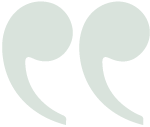

SOPHIE HILD

